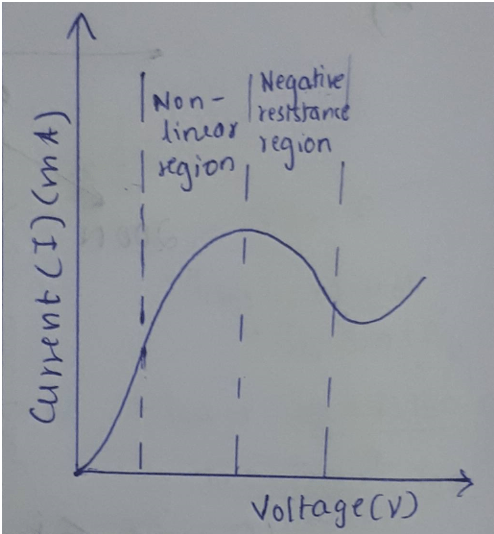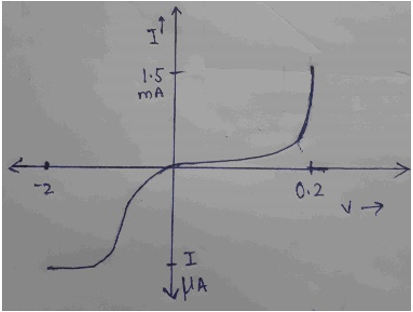This set of Class 12 Physics Chapter 3 Multiple Choice Questions & Answers (MCQs) focuses on “Limitations of Ohm’s Law”.
1. Identify the type of conductors whose V-I relationship is linear.
a) Thyristor
b) Non-ohmic conductors
c) Ohmic conductors
d) Superconductors
View Answer
Explanation: The conductors which obey Ohm’s law are called Ohmic conductors. The linear relationship between voltage and current for these conductors hold good.
2. Which of these relation holds good for an Ohmic conductor?
a) V-I relationship is non-linear
b) The straight-line V-I graph pass through the origin
c) V-I relationship is non-unique
d) V-I relationship depends on the sign of V for the same absolute value of V
View Answer
Explanation: The conductors which obey Ohm’s law are called Ohmic conductors. The linear relationship between voltage and current for these conductors hold good. The resistance (R=\(\frac {V}{I}\)) is independent of the current through the conductor. The magnitude of current changes linearly with voltage. Hence the V-I graph for ohmic conductors is a straight line passing through the origin.
3. Which of the following is an example of an Ohmic conductor?
a) Nichrome
b) Water voltameter
c) Gallium Arsenide
d) Thyristor
View Answer
Explanation: Most of the metals obey Ohm’s law and they are called ohmic conductors. Whereas semiconductors are non-ohmic. Nichrome metal is an ohmic conductor in which the V-I characteristic has a straight line passing through the origin.
4. Identify the type of conductor represented by the V-I characteristic curve given below.

a) Metallic conductor
b) Water voltameter
c) Thyristor
d) Semiconductor
View Answer
Explanation: The V-I graph gives the characteristic of a semiconductor. It exhibits non-linear behaviour. After a certain voltage, the current decreases as the voltage increases. Gallium arsenide shows this type of behaviour.
5. Identify the type of conductor represented by the V-I characteristic curve given below.

a) Metallic conductor
b) Thyristor
c) p-n junction diode
d) Semiconductor
View Answer
Explanation: p-n junction diode consists of p-type and n-type semiconductors. The V-I relationship is non-linear. When a voltage is applied across junction, very little current flows for the fairly high negative voltage and a current begins to flow for much smaller positive (forward) bias.
6. Ohm’s law is a fundamental law of nature. State true or false.
a) True
b) False
View Answer
Explanation: Ohm’s law is not a fundamental law of nature. Some reasons for the failure of ohm’s law are: Potential difference may vary non-linearly with the current ; The V-I relationship may be non-unique; The variation of current with potential difference may depend upon the sign of the potential difference applied.
7. For small currents, ‘X’ obeys Ohm’s law. But when large currents are passed through the same conductor, it deviates from ohmic behaviour. Identify X.
a) Metallic conductor
b) Gallium arsenide
c) Thyristor
d) p-n junction diode
View Answer
Explanation: ‘X’ is a metallic conductor. For small currents, it obeys Ohms’s law and its V-I graph is a straight line. But when large currents are passed through the same conductor, it gets heated up and its resistance increases. It no longer obeys Ohm’s law at higher currents.
8. Identify the type of conductor in which the variation of current with potential difference may depend upon the sign of the potential difference applied.
a) Metallic conductor
b) Thyristor
c) Water voltameter
d) p-n junction diode
View Answer
Explanation: p-n junction diode consists of p-type and n-type semiconductors. The V-I relationship is non-linear. When a voltage is applied across junction, very little current flows for the fairly high negative voltage and a current begins to flow for much smaller positive (forward) bias. The magnitude of variation depends upon the sign of potential difference applied across it.
9. Which of the following is an example of a non-ohmic conductor?
a) Copper
b) Silver
c) Silicon
d) Nichrome
View Answer
Explanation: Silicon is an example of a non-ohmic conductor. It exhibits non-linear behaviour. After a certain voltage, the current decreases as the voltage increases. The V-I plot for silicon is non-linear.
Sanfoundry Global Education & Learning Series – Physics – Class 12.
To practice all chapters and topics of class 12 Physics, here is complete set of 1000+ Multiple Choice Questions and Answers.
If you find a mistake in question / option / answer, kindly take a screenshot and email to [email protected]
- Check Class 12 - Physics Books
- Practice Class 11 - Physics MCQs
- Practice Class 12 - Biology MCQs
- Practice Class 12 - Chemistry MCQs
- Practice Class 12 - Mathematics MCQs
